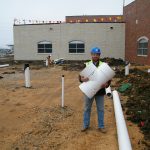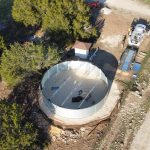Frequently Asked Questions List
Got a Burning Question? Search our website.
The FAQ List
The services we provide have many technical aspects. This FAQ section is intended to help you become more informed about the systems we design and install.
The FAQ list format makes it convenient to sort and search for the answers you need. Hopefully as your read through the list, you will discover answers to questions that you didn’t even know you had.
Within each of the FAQ list entries, we try to have a link to a FAQ blog post which will expand on the answer in the list entry.
Rainwater harvesting is the collection of precipitation from a surface to reuse at a later time. Most rainwater harvesting systems use roofs for the collection surface, but some rainwater harvesting systems do collect rainwater (or stormwater) from pervious surfaces.
For a more in-depth, detailed answer, see our “What is Rainwater Harvesting” FAQ blog post.
There are two types of pumps: centrifugal and submersible.
Centrifugal pumps are installed outside of the rainwater catchment cistern, typically inside of some sort of pump enclosure. While a pump motor can be loud, typical centrifugal pumps have a low noise level. In addition, if the pump is installed inside a pump enclosure, the enclosure can help to deaden the noise from the pump
Submersible pumps are installed inside of the rainwater collection cistern. Obviously for this type of pump, the noise volume is very low since the rainwater and the cistern will deaden the noise from the pump.
For a more in-depth, detailed answer, go to our FAQ blog post.
This answer is for irrigation practices in Texas.
Anyone installing, designing, repairing or selling an irrigation system must be licensed by the TCEQ. IWS has a licensed professional engineer and a licensed irrigator on staff.
Irrigation in Texas is regulated by:
Texas Commission on Envionmental Quality (TCEQ)
MC-178, P.O. Box 13087
Austin, Texas 78711-3087
Rainwater or stormwater runoff pooling at your house foundation can be due to many issues. If the water pooling is caused by a local roof gutter downspout, then it may be as simple as redirecting the downspout outlet to an area away from your foundation.
If the ground slope of our property causes stormwater runoff to pool near your house foundation, then you may need to correct the slope to allow the runoff to move to a lower elevation area or you may need to install a drainage inlet box at this low point and pipe the runoff underground to an area of lower elevation.
For a more in-depth, detailed answer, go to our FAQ blog post.
Graywater reuse is the reuse of wastewater from bathroom sinks, bathtubs and showers, and clothes washing machines. The mechanism to collect the graywater can be simple or complex.
For a more in-depth, detailed answer, go to our FAQ blog post.
Landscape is a key component in the overall water use of a house and property. In many areas of the US, water use for landscaping can account for more than 50% of the home’s water use during summertime.
Each plant type will have its’ individual water needs. The soil type will also dictate the amount of water required for the plant to thrive.
For a more in-depth, detailed answer, go to our FAQ blog post.
You should only install EPA Watersense labeled fixtures and plumbing components.
For a more in-depth, detailed answer, go to our FAQ blog post.
For people living in central Texas, many cities in that area offer rainwater harvesting system rebates. The cities of Austin, San Marcos, Sunset Valley, and Round Rock all offer rebates with Austin and San Marcos offering rebates up to $5000. Learn more about central Texas rainwater rebates.
The simple answer is… as large of a cistern that your budget allows. In central Texas, rainfall is feast or famine, so a larger cistern helps to capture more rainwater during the “feast” times of the year so that you can use it during the “famine” times.
While you certainly can use the rainwater from the cistern by gravity through a hose bibb, a pump system can provide the flexibility to be able to use the rainwater far away from the cistern or into an irrigation system.
Only rainwater harvesting systems that use a pump to use the rainwater out of the cistern is required to obtain an auxiliary water permit from the City of Austin. Therefore, if you are installing a rainwater harvesting system without a pump, then you don’t have to worry about a permit.
In addition, if you are installing a pump on the system, you will be required to install a special backflow prevention device called a Reduced Pressure Zone (RPZ) backflow prevention device at your water meter.
But now you may be asking, “I won’t be connecting my pressurized rainwater harvesting system to any municipal water pipes. Why do I still need to install this RPZ backflow prevention device?”. The simple answer is that your pressurized rainwater harvesting system has the “potential” to push untreated rainwater back into the municipal water grid just due the presence of the pump if a pressurized rainwater pipe somehow becomes connected to your house’s plumbing system. The pump can produce higher pressures than the municipal water pressure at your house, therefore pushing rainwater into the municipal water grid.
If you are not in the City of Austin, you definitely want to check with your municipality as they may have different permit requirements.
In the City of Austin, you are required to obtain an auxiliary water permit if you are installing a graywater reuse system. There are two types of permits for graywater reuse systems. One is a Homestead Permit which allows a homeowner to install a gravity based graywater reuse system that drains from your clothes washer. This is called a “laundry-to-landscape” system.
If you want to connect multiple graywater fixtures (shower/bath tub, bath sink, clothes washer) to a gravity based graywater reuse system or if you want to install a pressurized graywater system, then you will need to obtain an auxiliary water permit and the services of a professional engineer or master plumber to design and install your system.
In addition, by installing a pressurized graywater system, you will be required to install a special backflow prevention device called a Reduced Pressure Zone (RPZ) backflow prevention device at your water meter.
But now you may be asking, “I won’t be connecting my pressurized graywater system to any municipal water pipes. Why do I still need to install this RPZ backflow prevention device?”. The simple answer is that your pressurized graywater reuse system has the “potential” to push graywater back into the municipal water grid due the presence of the pump if a pressurized graywater pipe somehow becomes connected to your house’s plumbing system. The pump can produce higher pressures than the municipal water pressure at your house, therefore pushing graywater into the municipal water grid.
If you are not in the City of Austin, you definitely want to check with your municipality as they may have different permit requirements.
In most cases, you don’t need a permit from the city for drainage work on your property. If the work involves changing any structure on your property or involve any electrical work to install a sump pump, then a permit may be necessary. We will take care of any permitting needs if required for the implementation of the best solution for your drainage issue.
We are not a water restoration company that can come at a moment’s notice to remove water from your house. We are a company that can correct the issue if a drainage issue caused your house flooding. While we want to correct it as soon as possible for you, we do typically have a healthy construction schedule so the best advice is to contract with us soon after receiving our estimate so that your project can get locked in on our construction schedule.
If you are planning on building a new home, then you are in a perfect situation to plan for and install a graywater reuse system. This is the most economical way to install a total graywater reuse system (a system that captures all of the graywater sources within a house). You will be able to place the necessary dual plumbing to recover all of the graywater.
If you have a pier-and-beam home, then you also have a great graywater reuse potential. Most likey, we will be able to reach the graywater pipes in your crawlspace and route the graywater pipes to our reuse system.
If you have a concrete slab home, then it may be too expensive to install a total graywater recovery system. Retrofitting existing homes where the plumbing is located in a concrete slab is nearly impossible. If you have your clothes washer located on an outer wall, then we may be able to install a graywater reuse system that captures clothes washer water only.
The graywater recovery systems must be installed according to the current state and local regulations for graywater reuse so please check them before moving forward with any design or installation.
In some cases, we may be able to implement a “phased” solution for you. While we want to present an absolute solution and installation estimate to you, we do understand that we all have budgets. It could be possible to break up the solution especially if there are multiple systems involved in the complete solution for you. This is also a way to make sure you are spending an optimized amount for your drainage work. In some cases, it can be difficult to seeing all of the issues that are creating the exact drainage problem. A phased strategy allows us to implement one portion and see how much of an effect it has on solving the entire problem.
While the benefits of rainwater harvesting are numerous, the main benefit is that it is a sustainable water management practice that can be implemented by anyone on many different levels, from a simple rain barrel to a comprehensive rainwater harvesting system that integrates with an irrigation system or household plumbing.
Discover more benefits and advantages of rainwater harvesting in our FAQ blog.
Nothing. You can still supply your household with potable water during a drought. You just need to stay on top of monitoring your rainwater supply.
If the rainwater harvesting system was designed properly and is collecting from as much of the roof surfaces from your house, you will buffer the risk of running out of rainwater. Often, you will head into a drought with a relatively full cistern of rainwater. Even during a drought, we still get rain so there will be opportunities to replenish the rainwater volume in your cistern.
If the drought persists, then you can always call a local bulk water hauler to fill your cistern with hauled potable water so that you can bridge the gap between rain events.
It ultimately depends on three factors: roof collection area, rainwater cistern size, and local rainfall. You can read more about the exact method to calculate this amount at our FAQ post: How Much Rainwater Can I Collect From My Roof?
A rainwater harvesting system requires regular maintenance to ensure its efficiency and longevity. Routine tasks include cleaning the roof and gutters to prevent debris from contaminating the collected water, inspecting filters and screens to remove any blockages, and checking the storage tanks for signs of wear or leaks. Additionally, it’s essential to conduct periodic water quality tests and, if necessary, treat the harvested rainwater to maintain its purity, making sure the system functions optimally and provides a reliable source of clean water.
Learn more by viewing our blog post on the subject here







